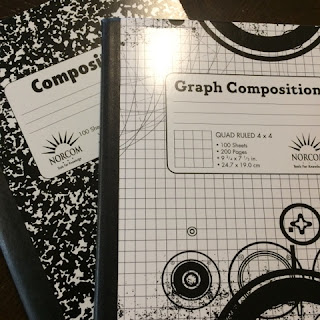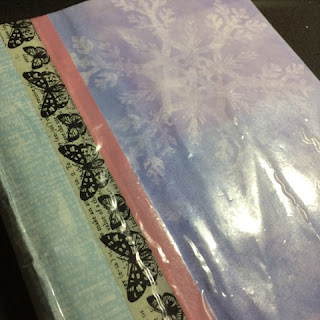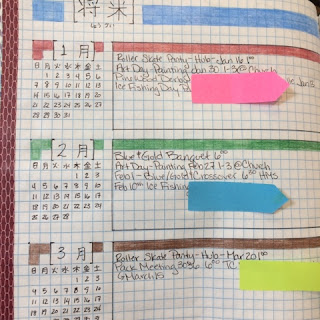 I got started because I had a blessing a number of years ago that said I needed to learn to be a "master of time management". It's truly a case of the Lord taking weak things and making them strong: I used to double book routinely, and I've been known to triple book myself. The most laughable example was that time I had my visiting teachers AND a thing I no longer remember happening at the same time as a piano lesson. A lesson I taught at the same time every week. It was pretty embarrassing. It was very me.
I got started because I had a blessing a number of years ago that said I needed to learn to be a "master of time management". It's truly a case of the Lord taking weak things and making them strong: I used to double book routinely, and I've been known to triple book myself. The most laughable example was that time I had my visiting teachers AND a thing I no longer remember happening at the same time as a piano lesson. A lesson I taught at the same time every week. It was pretty embarrassing. It was very me.I tried using my phone's calendar, but hated it. And I forgot to put things in it. And frequently neglected to look at it.
It was not effective.
A bujo, built in a $.50 notebook is.
I cover it with scrapbook paper and contact paper because that makes it tough -- my scripture journal has been drug around to church and back and wherever else since 2013, and it's still going strong, so I knew a composition book could take the kind of beating a planner has to be able to stand up to.
 This year, I found a notebook with graph paper. It rocks. I didn't buy enough; if my book gets full I may have to do something crazy and order one from Amazon or something, but it's totally be worth it, even if it costs more than the back to school sales I usually get my notebooks at. (It better last; the ones on Amazon are stupid expensive compared to the August sales!) Anyway. Get a graph paper composition book; you won't be sorry!
This year, I found a notebook with graph paper. It rocks. I didn't buy enough; if my book gets full I may have to do something crazy and order one from Amazon or something, but it's totally be worth it, even if it costs more than the back to school sales I usually get my notebooks at. (It better last; the ones on Amazon are stupid expensive compared to the August sales!) Anyway. Get a graph paper composition book; you won't be sorry!My bujo started out as a place to track my goals, and my long-term learning efforts, especially for Japanese. I actually didn't build the calendars right away; it was goal tracking I cared about first. A year later, the way I do it has evolved, but goals and long-term projects are still a huge part of my notebook. The instructional video for how to do a bullet journal says to set up your calendars first, but I don't follow directions well... I started out with what interested me: the "collections" or goal trackers.
It works great for that kind of thing: of the 14 goals that I listed a year ago, I've made satisfactory progress on most of them, and a several are completed. There are a couple of them that I gradually dropped: 14 is really quite a few, which I knew at the time that I made them. But I never have been good at moderation in the things I want to accomplish. I always bite off more than I can chew... but in attempting to do something huge, I usually end up actually accomplishing something satisfactory.
Don't tell me the sky's the limit when
there are footprints on the moon.
-Unknown
The monthly calendar is quick to build because it isn't anything fancy. When I did it in the notebook with lines I did it as a list; in my graphpaper notebook that doesn't work well, so I switched to a regular calendar format. Either way, I end up with a two pages, and room around the edges for notes. Space to jot notes has become a thing that I plan into my bujo in a couple of places. It would be nice to have a premade calendar, but this is almost the only page that it would work to do that, and so it's worth it to build these. It really doesn't take that long: probably about 10 minutes per month. For things further out than that, I have what's called a "Future Log" to keep track of them. There's not actually that much that gets scheduled that far out: dental cleanings, and Dragon's Tiger Scouts people had the whole year mostly planned out, a handful of things for our homeschool group... usually months will have 3-4 items on them when I go to put them on the bigger calendar, so you can get a lot of months on a page.
 Originally, I used a daily to-do list, and didn't build a weekly spread. But I found that daily lists meant that I was moving a lot of things to a new list a lot of days: although it worked better than the nothing I'd had previously, it wasn't efficient. However, I have tons of things I want to accomplish each week, but I just slide them in
the cracks where they fit, and that's hard to plan out super
specifically. However, the list helps make it happen more often. So I
didn't want to just drop the daily list, like this one from last year. Not entirely, anyway.
Originally, I used a daily to-do list, and didn't build a weekly spread. But I found that daily lists meant that I was moving a lot of things to a new list a lot of days: although it worked better than the nothing I'd had previously, it wasn't efficient. However, I have tons of things I want to accomplish each week, but I just slide them in
the cracks where they fit, and that's hard to plan out super
specifically. However, the list helps make it happen more often. So I
didn't want to just drop the daily list, like this one from last year. Not entirely, anyway.So instead of a new to-do list every day, I've moved to a 2-page weekly spread that basically minds all my things that I want to accomplish in the week: appointments, things with deadlines, ongoing projects, lesson plans, daily chores, and space for notes. There's almost always some kind of notes that go with the week's events. I do the days of the week in Japanese, which has helped me to finally get comfortable using those. As I've figured out the vocabulary, some of my list headings are usually in Japanese, too: familiarity breeds fluency, and there's nothing like writing it out every week to make it familiar!
The main section on the first page is the weekly calendar: on the right, there's a list of appointments, with times and typically places. On the left is the to-dos that have a specific deadline: things that MUST be done by a certain time or on a certain day. This one (still only partly filled out) is for next week. I've already added a dentist visit, and I still need to look at the monthly calendar to see what else needs to be on here.
 Below that is my daily habits chart. I took the Sweep & Smile course that Mystie Winkler offers. (Totally worth the price, btw.) The best parts of that course are where she talks about the purpose of homemaking, and connects our work at home to our service to the Lord. But the most practical bits were the parts where she helped us to set up routines to get things done. It's been totally revolutionary: I actually kind of feel on top of my house from time to time now. Sometimes. (As opposed to always drowning.) That's partly attitude shift, but partly it's new skills. And I track and maintain those skills in this section. I also mind some of my self-care and my martial arts practice here.
Below that is my daily habits chart. I took the Sweep & Smile course that Mystie Winkler offers. (Totally worth the price, btw.) The best parts of that course are where she talks about the purpose of homemaking, and connects our work at home to our service to the Lord. But the most practical bits were the parts where she helped us to set up routines to get things done. It's been totally revolutionary: I actually kind of feel on top of my house from time to time now. Sometimes. (As opposed to always drowning.) That's partly attitude shift, but partly it's new skills. And I track and maintain those skills in this section. I also mind some of my self-care and my martial arts practice here.Can I just say how much I enjoy coloring in those boxes? I keep the book open in my kitchen, next to a bag of colored pencils. I switch colors nearly every box. The more I do, the happier my page looks. I love coloring boxes; I will write things down after they're done just so I can color a box. It's ok to chuckle; I do. But it works.
 Next to my routine tracker, I track the ongoing study projects: I decide (kind of realistically) how much I think that I can do this week, and draw some boxes. Usually I have leftover ones, but typically over a couple of weeks everything gets at least a little bit of attention. Which is how I did so well on this year's Resolutions: small measurable goals, monitored regularly. And boxes that I love to color in.
Next to my routine tracker, I track the ongoing study projects: I decide (kind of realistically) how much I think that I can do this week, and draw some boxes. Usually I have leftover ones, but typically over a couple of weeks everything gets at least a little bit of attention. Which is how I did so well on this year's Resolutions: small measurable goals, monitored regularly. And boxes that I love to color in.It was 6 or 8 months from when I started using a bujo before it occurred to me to put my lesson plans in my notebook. I had them on my computer before, and it was an ok system, but it's hard to have them there, because then when a kid is on my computer (a couple of Hero's books are online etxts of classics that are out of copyright) I can't check on my plans and get the next thing ready. Now that Miss Kitty is starting to do a little bit of school, I find that I have to be much more efficient: I needed my plans more where I can get them when I need them. They are *much* more accessible in my notebook than they are on my computer. And in doing them, I needed a week-at-a-glance schedule because I have a plan for the week, but we don't do the same thing every day, and we don't hit everything every week. I asked the ladies of the Ambleside Online facebook group how they plan, they kindly showed me, and that's when things started to click for me with scheduling school in my notebook.
First, I make a grid for each of the kids that shows what books they're reading and what sections they should be doing each week. Hero's is pretty busy; Miss Kitty's is super simple. Dragon has one, too. Each one is customized to what that kid is studying. Subjects that are just "do what's next" kinds of things just get listed at the bottom, which helps me remember them when I make my weekly schedule of boxes to color.
In theory we do school six weeks on one week off year round. In reality, it often takes us 7 or even 8 weeks to work through my six week plan. This happens for a number of reasons: I'm an over-planner, perpetually optimistic about what we can accomplish. Inevitably something comes up (today we had cousins in town from Colorado unexpectedly). Life happens. The great thing is, I just cross off what we do, and pick up where we left off the next time. It works out great. We have certain things that are daily no matter what; the stuff on my schedule is kind of looped: we finish one week before doing much in the next one. I've got some larger-scale planning here on the blog that I refer to when I'm making this chart; I also use the Ambleside Online schedules when I make these. Not only are the book selections at Ambleside excellent, but they also have a very realistic sense of what can actually be done in a week, which is super helpful.
 I've also got a page that's supposed to help me do our drills for Japanese. In reality, this system needs tweaking still: I've got a breakdown between the planning and the actually doing it. But even with that issue, having it planned out means that I'm getting it done occasionally, which is more than we were doing before. More would be better; some is good.
I've also got a page that's supposed to help me do our drills for Japanese. In reality, this system needs tweaking still: I've got a breakdown between the planning and the actually doing it. But even with that issue, having it planned out means that I'm getting it done occasionally, which is more than we were doing before. More would be better; some is good.Once I've got my 6 week schedule, it's time to make a weekly schedule. This means that I count up how many days I think it's going to take to do each thing, and draw a box for each one of them. Math and violin get 5 boxes each: they're done every day. The kids get some kind of writing every day, but it varies: Hero can expect to split his days between grammar work, spelling lessons, and written narrations -- sometimes more than one category in a day. Dragon's load is a little lighter: he's not doing written narrations yet, but he does copy work most days. Some readings we do only once a week. Plutarch and Shakespeare are actually looped, so we'll do several weeks of the one, then switch and do the other for a while.
When I put things on the schedule, I have three sections: one for each kid and one for the things we all do together. As always, because I'm a chronic overscheduler, there are going to be empty boxes at the end of the week. But because I cross things off the six week chart, the things that get missed in one week get hit another week. It's rare for something to be dropped altogether. I've developed a feel for how many boxes we should have colored in at any given point in the week, so I can monitor how much we're doing at a glance, and having the other chart keeps us on track over the long haul, so although they look a little bit duplicative, they're not really. I use washi tape between the lines because it makes a sharp distinction between the sets of work, and because it's pretty. Also it's fast and easy to put on.
 Under my lesson plans, I've got a block for taking notes: addresses for places we need to go, things I want to remember, stuff I want to ask somebody... all kinds of stuff ends up there. And next to that is my week's to-do list. I love the Japanese phrase for this: "things I want to do". That about sums it up perfectly. These are things that I'd like to accomplish or that I need to accomplish, but that don't have a particular deadline. If I want to work on a thing more than once, it gets a second box. This week was pretty typical: there were several boxes that didn't get colored. A half-colored box means that I worked on it, but it's not done.
Under my lesson plans, I've got a block for taking notes: addresses for places we need to go, things I want to remember, stuff I want to ask somebody... all kinds of stuff ends up there. And next to that is my week's to-do list. I love the Japanese phrase for this: "things I want to do". That about sums it up perfectly. These are things that I'd like to accomplish or that I need to accomplish, but that don't have a particular deadline. If I want to work on a thing more than once, it gets a second box. This week was pretty typical: there were several boxes that didn't get colored. A half-colored box means that I worked on it, but it's not done.At the end of each week, I build the next week's page. Takes about 20 minutes, but it's such an amazing tool for keeping things humming all week that it's totally worth the time. The boxes for lesson plans tend to be the last thing added, but I hate facing Monday morning without them, so I work hard to make sure they're ready to go before I sleep Sunday night.
 There's other stuff I do in my book, too. This will be the second year that I've done a list for Christmas cards. It is currently telling me that I need to get hopping. But it's set up so that I can mark each family as we write the card and again when it's actually mailed. That was so nice to be able to check on last year.
There's other stuff I do in my book, too. This will be the second year that I've done a list for Christmas cards. It is currently telling me that I need to get hopping. But it's set up so that I can mark each family as we write the card and again when it's actually mailed. That was so nice to be able to check on last year.There's a page for menu planning. Which takes the thinking right out of it, and I can make a menu so much faster now (and without feeling the need to whine on Facebook!). Getting the menu made quickly and painlessly is good!
 The menu maker is stratigically located at the front of the notebook, as is my birthday calendar. This calendar was one place where I allowed myself to get a little arty. It's based on this layout I found on Pinterest. Making it arty makes it nice to look at, which makes me more likely to use it... and I've actually been kind of successful at calling people and telling them happy birthday since I made it! That's huge. It's another thing that I'm not at all good at doing, but I think the tool will help me be better at connecting with my family on their day.
The menu maker is stratigically located at the front of the notebook, as is my birthday calendar. This calendar was one place where I allowed myself to get a little arty. It's based on this layout I found on Pinterest. Making it arty makes it nice to look at, which makes me more likely to use it... and I've actually been kind of successful at calling people and telling them happy birthday since I made it! That's huge. It's another thing that I'm not at all good at doing, but I think the tool will help me be better at connecting with my family on their day. I've also used the notebook for taking notes at my little kids' violin lessons. Hero doesn't need that kind of support as much anymore, as he's moving nicely toward more independence in a number of areas, but for my younger kids, it was really nice to have notes on what their teacher had said. We're between teachers right now, which makes those notes especially important, as she gave them some things to work on until we find a new teacher.
I've also used the notebook for taking notes at my little kids' violin lessons. Hero doesn't need that kind of support as much anymore, as he's moving nicely toward more independence in a number of areas, but for my younger kids, it was really nice to have notes on what their teacher had said. We're between teachers right now, which makes those notes especially important, as she gave them some things to work on until we find a new teacher.I've planned out special projects in the planner as well. This page is one I did when I wanted to make pegdolls for A Winter's Tale, which was our most recent Shakespeare play.
This style of tracker I've somewhat moved away from, because my weekly page has taken it all in, but for much of this past year, these were the backbone of my progress: a list of things I want to do, with days across the top, and color in the boxes on the days when I get it done.
Hopefully peeking into my book is helpful to you. A bullet journal is a fantastic system. Good luck building one that will work for you!













1 comment:
Wow! So that is what bullet planning is all about!! I might have to look into that in the future..right now I have three planners going-one for homeschool, one for blogging and one for home/work. I will probably have to keep the homeschooling one because my daughter likes to look in it and see the plan for the day :) I like the idea of coloring in boxes, it makes it pretty :) Nice information and I might have to check out that course on housekeeping!!
Post a Comment